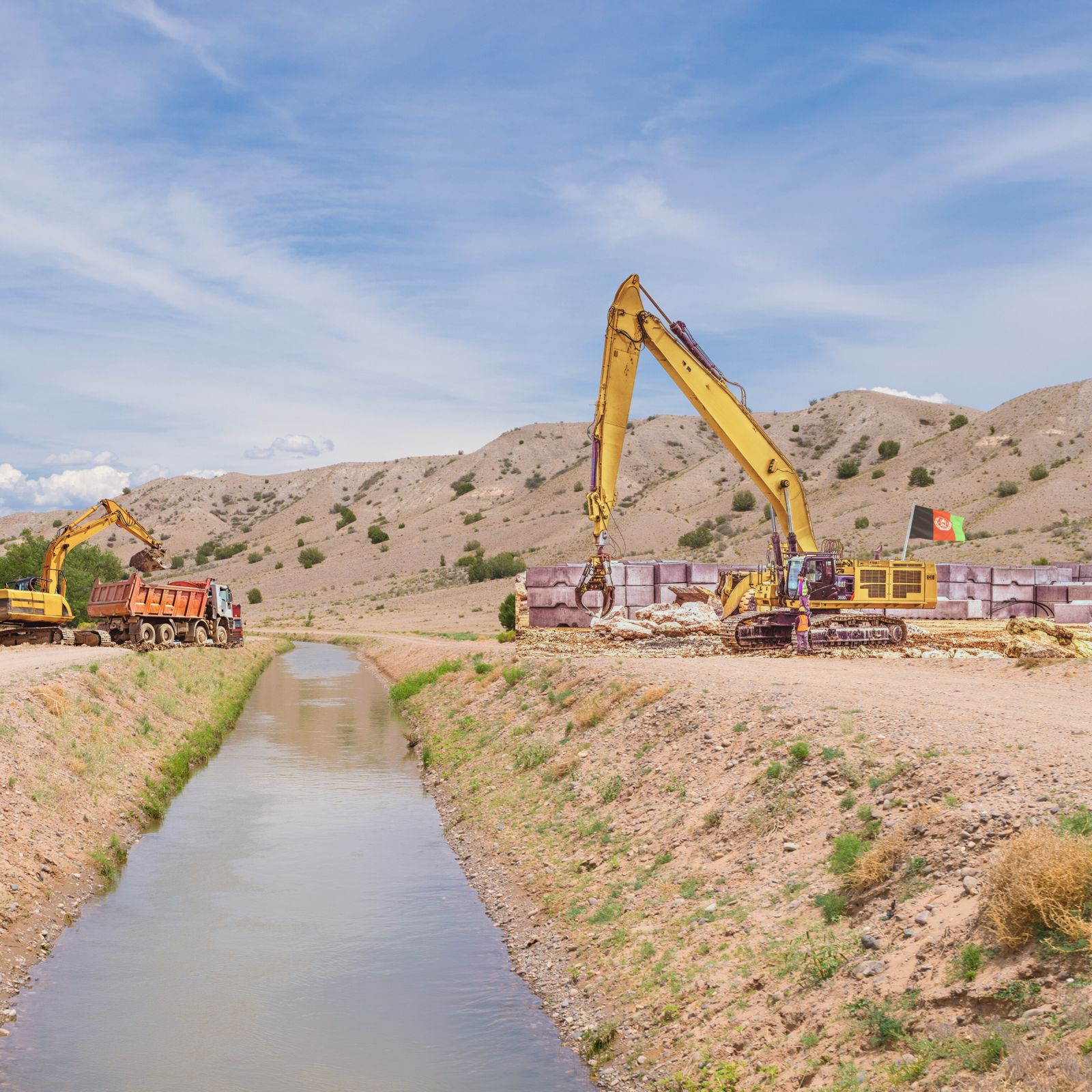
By Aiman Smagulova
Editors: Katie Farrell and Muhammad Hani Ahsan
Graphic by: Ava Lagressa and Arsh Naseer
The construction of the Qosh Tepa Canal in the north of Afghanistan by the Taliban Government in 2022, represents one of the country’s largest projects, costing $684 million and involving over 4,000 workers.1 Designed to enhance both agricultural and humanitarian conditions, the Canal spans over 2,100 square miles and aims to address water scarcity, boost agriculture, and potentially generate 250,000 jobs, significantly impacting Afghanistan’s economy.2
Initially conceived in the 1970s by Afghanistan’s former government and supported by the United States Agency for International Development (USAID), construction of the canal commenced under Taliban rule. The plan involved constructing a 200-kilometer irrigation canal that would impact more than 60,000 households and cultivate a catchment area of 500,000 hectares.3
The Qosh Tepa Canal also raises concerns due to its water extraction from the critical Central Asian River, Amu Darya, which sustains the livelihoods of over 40 million people. Afghanistan’s plan to divert 10 billion cubic meters or 20% of Amu Darya’s water to the Qosh Tepa Canal4 is expected to have irreversible consequences. This article analyzes the implications of building the Qosh Tepa Canal in Central Asia and Afghanistan.
Historical Background
Historically known as the Oxus, Amu Darya, along with Syr Darya (known as Jaxartes), are the largest rivers in Central Asia. The Amu Darya flows through Tajikistan, Afghanistan, Turkmenistan, and Uzbekistan, while Syr Darya courses from Kyrgyzstan through Uzbekistan and Kazakhstan. Both rivers have been crucial for the water supply of the Aral Sea.
During the 1950s, the Soviet policy aimed at boosting agriculture, particularly cotton production in Central Asia, resulted in a reduced water supply to the Aral Sea. The Amu Darya and Syr Darya became primary sources of water for cotton production. While Central Asia emerged as the world’s fourth-largest cotton producer, the Aral Sea, reliant on water from the Amu Darya and Syr Darya, underwent desiccation. Redirecting the Amu Darya reduced the Aral Sea’s size and also prevented the river from reaching its terminus. This anthropogenic catastrophe led to heightened salinity, increased temperatures, and dust storms, exacerbating climate change and negatively impacting flora and fauna.5 The region faces a significant threat from toxic salts and minerals, posing risks to crops and public health, including anemia, elevated mortality rates, and respiratory and intestinal ailments.
It is essential to note that the Aral Sea and its basin play a crucial role in regulating the climate in the region. The desiccation of the sea has led to significant climate changes in the coastal area and has impacted the entire atmospheric circulation system in its basin. Summer and winter air temperatures near the seashore have increased by 1.5–2.5°C, and diurnal temperatures have risen by 0.5–3.3°C.6 The temperature increase is expected to cause glacial melt in the Pamir and Tian Shan, increasing the flows of the Amu Darya and Syr Darya for a few decades. However, this will be followed by a severe reduction in flow as the glaciers disappear.
Legal Aspects
Following the dissolution of the Soviet Union, Central Asian countries entered into the Almaty Agreement, which upheld the Protocol 566 allocation quotas inherited from the Soviet Union. The Preamble of the Almaty Agreement foresees that “only collaboration and coordination of actions will contribute to creating favorable conditions for addressing socio-economic problems. It will allow mitigating and stabilizing environmental tensions that have arisen as a result of the depletion of water resources”.7
Under the Protocol, the parties agreed to withdraw water in the amount of 61.5 cubic kilometers for four Central Asian states. Although Afghanistan was not a party, the Protocol contained assumptions that Afghanistan was withdrawing 2.1 cubic kilometers.8 Following the Almaty Agreement, the Central Asian states also created the Interstate Coordinating Water Commission (ICWC), aimed at addressing the regulation, rational use, and protection of water resources from interstate sources. As a result of the institutional reforms, ICWC merged with the International Fund for Saving the Aral Sea (IFAS).
Although Afghanistan is not a party to this regional treaty governing the allocation of the Amu Darya River’s water, certain principles embedded in the Almaty Agreement align with customary international law, binding Kabul legally. The 1997 UN Convention on the Law of Non-Navigational Uses of International Watercourses (1997 UN Convention) codifies some of these customary principles, including equitable and reasonable utilization, the obligation not to cause harm to other riparian states, and the obligation to cooperate. Neither Central Asian countries nor Afghanistan have claimed to be persistent objectors to the UN Convention, meaning that these principles are legally binding.
The principle of equitable and reasonable utilization, established in the 1966 Helsinki Rules on the Uses of the Waters of International Rivers and recognized as customary law in the Gabcikovo Nagymaros case9, grants the right to utilize shared water resources while imposing a duty to prevent harm to other riparian states. In the preparatory documents – travaux preparatoire – for the 1997 UN Convention, it was stipulated that “international watercourse shall be used and developed by watercourse States to attain optimal utilization thereof and benefits therefrom consistent with adequate protection of the watercourse”.10 The emphasis is on utilizing water equitably to achieve optimal benefits rather than dividing it into equal amounts among the states sharing the watercourse. Examining this principle and the water quotas outlined in Protocol 566, it appears that the amount of water Afghanistan extracts from the Amu Darya does not accurately depict the country’s actual needs. The water usage in both Central Asia and Afghanistan falls short of ensuring sufficient protection for the watercourse.
The second fundamental customary principle is the no harm principle, rooted in the Roman civil law maxim “sic utere tuo ut alienum non laedas,” which dictates that one’s rights should not infringe upon the rights of others. Article 7 of the 1997 UN Convention stipulates that states must “take all appropriate measures to prevent causing significant harm” to other states sharing an international watercourse. The principles of equitable and reasonable utilization and the prevention of significant harm work in tandem: if a state believes it has suffered substantial harm due to another co-riparian state’s use of an international watercourse, it will typically address the matter with the second state.11
As for the principle of obligation, it is also noteworthy that the Taliban Government, seeking international recognition, trade, and infrastructure investments, prioritizes positive diplomatic relations with northern neighbors such as Uzbekistan and Turkmenistan. These countries are vital for supplying electricity and gas to Afghanistan. Any discord could jeopardize regional ties, impact trade, and potentially isolate Afghanistan. The absence of Afghanistan in regional water agreements and organizations like the IFAS further complicates cooperation on water management in the region.
Water Security
Approaching the United Nations Sustainable Development Goals deadline in about six years, the global community lags in achieving its water-related objective of ensuring access to water, sanitation, and hygiene. Escalating population, urbanization, and growing water requirements for agriculture, industry, and energy contribute to the increasing demand for water. Moreover, given the interconnected nature of water-related risks with conflict, instability, migration, human health, and food security, achieving water security on both national and international levels appears exceedingly challenging. Central Asia and Afghanistan exemplify this trend, and the construction of the Qosh Tepa Canal further complicates the situation.
By extracting 10 billion cubic meters of water from the Amu Darya River in the Kaldar District of Balkh Province, the Canal has the potential to decrease downstream flows to Uzbekistan and Turkmenistan by 15%12. This reduction could lead to water scarcity in downstream countries in light of the World Bank’s estimation that the lack of fresh water in Central Asia within 30 years could result in an 11% drop in GDP13. Given that irrigated agriculture and hydroelectric power generation are dependent on water, the diversion of Amu Darya for the Canal poses challenges to the stressed water supply in the region. Afghanistan’s increased water diversion may exacerbate existing water scarcity issues, affecting downstream countries’ water levels.
Moreover, the Amu Darya River plays a vital role as a primary source of drinking water for the growing population in the region. Careless water utilization has the potential to increase water demand in both Central Asia and Afghanistan. Presently, the World Health Organization notes that 20% of Uzbekistan’s population14, 45% of Tajikistan’s population15, and 5% of Turkmenistan’s population16 lack access to safe drinking water. In Afghanistan, only 42% of the population has access to safe drinking water17.
Considering the political instability in Afghanistan that has done substantial harm to water infrastructure, 53% of water points throughout the country face depletion18. Individuals facing scarcity may move to regions near the Canal hoping to access clean water. However, it remains uncertain who will manage the utilization and allocation of water among the population and whether this could lead to political and social escalation in Afghanistan. Hence, with water resources being finite, the rising demand for water due to population and economic growth intensifies competition and the potential for conflict among the Central Asian states and Afghanistan.
Environmental Impact
The construction of the Qosh Tepa Canal reveals various adverse environmental effects arising from the building process. Satellite assessments indicate that the primary method employed during construction involved rudimentary excavation, lacking a sufficient foundation for the Canal’s surface areas. These rudimentary construction techniques pose a potential future risk of significant water seepage and preventable losses. According to efficient water engineering practices, the Canal should be lined with optimal materials, such as plastic liners, bricks, or concrete to minimize leakage into the ground, thereby reducing the amount reaching the intended irrigated field. The Qosh Tepa Canal should be covered with solar panels to reduce evaporative loss and shade, keeping the water cooler.
Second, the building of the Qosh Tepa Canal necessitates a thorough assessment of its environmental and social impacts to comprehend potential effects on the river, freshwater resources, and biodiversity. Changes in water availability and rising temperatures may instigate new pest outbreaks and an increased prevalence of invasive species. Drier conditions and prolonged heatwaves also heighten the risk of wildfires. For instance, there are concerns among experts regarding the endangered Amu Darya sturgeon and the vulnerability of the Prearalie floodplains19.
Third, the Qosh Tepa Canal should be rationally maintained to avoid aquatic weeds, creating pathways for non-native species and exotic pathogens, reducing the genetic diversity of native species and populations, and potentially serving as an ecological trap. These adverse effects primarily stem from the novel connections formed by canals between previously isolated ecoregions and river basins.
Moreover, there is a high risk that the Canal will cause salination not only in Afghanistan but throughout the region20. Following a perpendicular path, the Canal will either intersect or border foothill plains and river deltas, each with its established hydrological and hydrodynamic regime. This disruption will affect the existing groundwater flow to the Amu Darya, causing an elevated groundwater level and the salinization of agricultural land21. Over time, some areas would become waterlogged and be removed from agricultural use.
Given the limited water resources in the Amu Darya, the construction of the Canal should prompt both Central Asian countries and Afghanistan to embrace an innovative approach to agriculture. Tactics such as implementing a sustainable agriculture program become essential to ensuring the efficient use of water. This program might involve adopting drip irrigation to minimize water loss, selecting plants with lower water requirements, and enhancing soil health, particularly organic matter content, to retain higher soil moisture. While this initiative demands substantial investments, it promises to utilize Amu Darya water more effectively in the long term, mitigate the impact of climate change, and maintain ecological equilibrium.
Nonetheless, the Taliban government, isolated globally with limited financial support, economic collapse, and a lack of access to offshore assets, is unlikely to prioritize environmental concerns over the construction of the Canal. Domestically, the Qosh Tepa Canal serves as a critical assessment of Kabul’s governance capabilities, while internationally, it will have leverage over the Central Asian States.
Conclusion
While the Qosh Tepa Canal symbolizes hope for the Taliban government to demonstrate its governance capabilities and provides access to crucial resources for the population, it could also become a source of conflict if equitable and reasonable utilization of the Amu Darya is not agreed upon by Afghanistan and Central Asian states. Emphasis must be placed on sustainable Canal maintenance, the establishment of eco-friendly irrigation practices to prevent soil degradation, and integrated water resource management, ensuring sustainable agriculture in both Central Asia and Afghanistan. As the acting government of Afghanistan, the Taliban should be involved in negotiations, considering participation in regional agreements and international organizations. Delaying water cooperation on the Amu Darya increases the risk of conflict, given factors such as a growing population, limited water access, and the threats of desertification and climate change.
Reference
[1] Global Waters. 2018. “Feasibility Study for Khush Tepa Irrigation Canal Ceremony Held.” Accessed March 1, 2024. https://www.globalwaters.org/sites/default/files/Afghanistant-2018.12.10-Press-Release-feasability-study.pdf.
[2] Ozat, Meray. 2023. “Afghanistan’s Canal Project Threatens Central Asian Water Security.” Accessed March 9, 2024. https://www.caspianpolicy.org/research/energy-and-economy-program-eep/afghanistans-canal-project-threatens-central-asian-water-security.
[3]Global Waters. 2018. “Feasibility Study for Khush Tepa Irrigation Canal Ceremony Held.” Accessed March 1, 2024. https://www.globalwaters.org/sites/default/files/Afghanistant-2018.12.10-Press-Release-feasability-study.pdf.
[4] Ozat, Meray. 2023. “Afghanistan’s Canal Project Threatens Central Asian Water Security.” Accessed March 9, 2024. https://www.caspianpolicy.org/research/energy-and-economy-program-eep/afghanistans-canal-project-threatens-central-asian-water-security.
[5] Micklin, Phillip. 1991. The Water Management Crisis in Soviet Central Asia. Pittsburg: Carl Beck Peppers.
[6] Lioubimtseva, Elena. 2013. “Impact of Climate Change on the Aral Sea and Its Basin.” The Aral Sea, July 27: 405–27. https://doi.org/10.1007/978-3-642-02356-9_17.
[7] “Agreement between the Republic of Kazakhstan, the Kyrgyz Republic, the Republic of Tajikistan, Turkmenistan, and the Republic of Uzbekistan on Cooperation in the Field of Joint Management on Utilization and Protection of Water Resources.” 1992. Concluded February 18, 1992. http://www.icwc-aral.uz/statute1.htm.
[8] Kamil, Ikramuddin. 2021. “Afghanistan, the Amu Darya Basin, and Regional Treaties.” Chinese Journal of Environmental Law 5, no. 1: 37–62. https://doi.org/10.1163/24686042-12340063.
[9] Case Concerning the Gabcikovo-Nagymaros Project (Hungary v. Slovakia). 1997. Judgment, International Court of Justice, September 25
[10] United Nations. 1997. “Convention on the Law of the Non-Navigational Uses of International Watercourses.” United Nations Treaty Series, registration no. 49. https://legal.un.org/ilc/texts/instruments/english/conventions/8_3_1997.pdf.
[11] Ibid
[12] Centralasia Media. 2016. “Нехватка пресной воды в Центральной Азии может привести к падению ВВП на 11%, – исследование ВБ.” (Fresh Water Shortage in Central Asia Could Lead to 11% Decrease of GDP) Accessed March 1, 2024. https://centralasia.media/news:1121030.
[13] World Bank. 2016. “High and Dry.”Accessed March 1, 2024. http://hdl.handle.net/10986/23665.
[14] World Health Organization. 2023. “Health and Environment Scorecard: Uzbekistan.” Accessed February 17, 2024. https://cdn.who.int/media/docs/default-source/country-profiles/environmental-health/environmental-health-uzb-2023.pdf?sfvrsn=6ca8c302_11&download=true.
[15] World Health Organization. 2023. “Health and Environment Scorecard: Tajikistan.” Accessed February 17, 2024. https://cdn.who.int/media/docs/default-source/country-profiles/environmental-health/environmental-health-tjk-2023.pdf?sfvrsn=9dc03edd_13&download=true.
[16] World Health Organization. 2023. “Health and Environment Scorecard: Turkmenistan.” Accessed February 17, 2024. https://cdn.who.int/media/docs/default-source/country-profiles/environmental-health/environmental-health-tkm-2023.pdf?sfvrsn=37810444_14&download=true.
[17] U.S. Agency for International Development. 2023. “Rural Water, Sanitation and Hygiene | Afghanistan.” Accessed February 17, 2024. https://www.usaid.gov/afghanistan/fact-sheet/rural-water-sanitation-and-hygiene-0.
[18] United Nations International Children’s Emergency Fund (UNICEF). 2022. “Afghanistan Wash on the Brink.” Accessed February 17, 2024. https://www.unicef.org/media/118356/file/UNICEF%20Afghanistan%20WASH%20on%20the%20Brink%202022.pdf.
[19] Lioubimtseva, Elena. 2013. “Impact of Climate Change on the Aral Sea and Its Basin.” The Aral Sea, July 27: 405–27. https://doi.org/10.1007/978-3-642-02356-9_17.
[20] The Third Pole. 2023. “A Lot of Work for Diplomats in Central Asia as the Taliban Build Huge Canal.” Accessed February 17, 2024. https://www.thethirdpole.net/en/regional-cooperation/a-lot-of-work-for-diplomats-as-taliban-build-qosh-tepa-canal/.
[21] Ibid






Leave a Reply